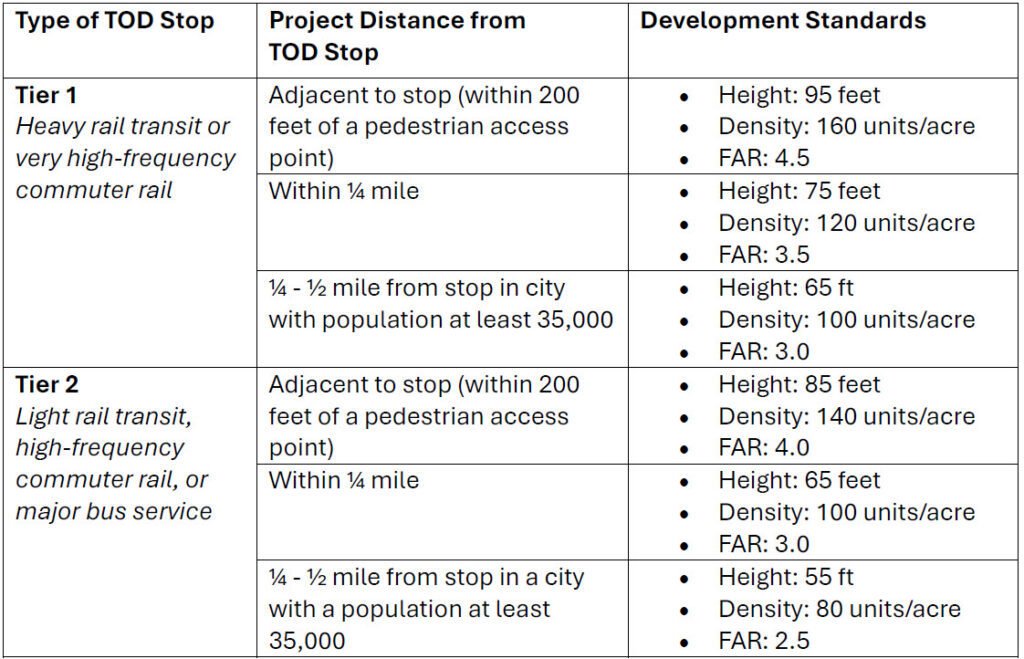Update: Governor Newsom signed SB 79 into law on October 10, 2025
California Legislature Passes New Bill to Encourage More Homes Near Transit
Capping off a session that achieved major CEQA reforms for housing development, the California Legislature has sent new transit-oriented housing legislation to the Governor’s desk, which is expected to be signed by the October 12 deadline. Senate Bill 79, the “Abundant and Affordable Homes Near Transit Act” (Wiener), effectively upzones sites near high-quality transit to create more housing opportunities. Below we summarize SB 79 and its eligibility requirements.
Key Points
- The bill affects cities in eight urbanized counties that are well-served by transit.
- In these areas, the bill allows building height limits of 55 to 95 feet and density of at least 30 units per acre, depending on proximity to and quality of transit.
- Projects over 10 units must meet basic inclusionary housing requirements.
- No specific labor requirements apply unless the building is over 85 feet in height.
- The bill expands eligibility for CEQA-exempt streamlining under SB 423, and lowers the inclusionary housing requirement.
- Local jurisdictions have options to exempt certain sites from the bill, or adopt an alternative plan that achieves the same development capacity.
What projects qualify for SB 79?
SB 79 applies to projects in proximity to a “transit-oriented development” (TOD) stop, which is:
- A “major transit stop” (as defined in Public Resources Code Section 21064.3); and
- In an “urban transit county,” defined as a county with more than 15 passenger rail stations. In the Bay Area, this means San Francisco, Alameda, San Mateo, and Santa Clara Counties – with Contra Costa County notably omitted – as well as Sacramento, Los Angeles, Orange, and San Diego Counties.
Once signed, SB 79 will become effective on July 1, 2026, unless a local jurisdiction adopts an HCD- approved ordinance or local transit-oriented development alternative plan before then.
What are the requirements for a “transit-oriented housing development”?
- The project must be a “housing development project” as defined in the Housing Accountability Act (HAA).
- The site must be zoned residential, mixed or commercial, and be within at least ½ mile of a transit-oriented development stop.
- The project must include:
- At least five dwelling units;
- Density of either 30 dwelling units per acre, or the minimum density required under local zoning; and
- Average total floor space per unit cannot exceed 1,750 square feet.
- Projects with more than 10 units must include housing affordable to households at the following levels based on Area Median Incomes, unless the local ordinance mandates a higher percentage:
- 7% of units: extremely low income households;
- 10% of units: very low income households; or
- 13% of units: lower income households.
- The project cannot be located on a site that has had more than two rent-controlled units within the past seven years.
- The project must comply with height, noise, and safety standards of adopted airport land use plan or zone, and fire safety standards.
- Projects are also able to take advantage of density bonus concessions, depending on the minimum density achieved for a given project.
- Finally, no labor requirements apply to buildings 85 feet in height or less. For any building over 85 feet in height, the project must comply with prevailing wage requirements and must use a skilled and trained workforce.
SB 79 also allows local transit agencies to develop on land owned by the agency, subject to specific requirements, including paying prevailing wages and using a skilled and trained workforce.
What development standards apply to projects under SB 79?
SB 79 limits a local agency’s ability to restrict certain development standards for transit-oriented housing developments. It also distinguishes between types of TOD stops based on the type of transit that serves the stop.
- Tier 1 TOD stops are served by heavy rail transit or very high-frequency commuter rail (such as BART and Caltrain).
- Tier 2 TOD stops are those that are not Tier 1, and are served by light rail transit, high-frequency commuter rail, or major bus service (such as San Francisco Muni; not including Amtrak or the California High-Speed Rail).
Under SB 79, local agencies cannot set limits below the following standards depending on the project’s proximity to the TOD stop:
Are projects under SB 79 eligible for streamlined approval?
Projects under SB 79 may be eligible for streamlined ministerial approval under SB 35/423, which provides a streamlined ministerial approval process for developments in localities that have not made sufficient progress toward housing targets, with certain significant changes that will make that process attractive for more projects. For eligible projects, SB 35/423 mandates a very fast process (approximately 90 to 180 days, depending on project size) and one that is exempt from CEQA. However, in most jurisdictions, projects are required to include 50% low income units to qualify for SB 35/423, and as a result, it has primarily been used by 100% affordable projects.
SB 79 makes two significant changes to this framework. First, eligibility does not depend on whether the jurisdiction has met its housing allocation targets, meaning that it can be used in every jurisdiction where SB 79 applies, regardless of the jurisdiction’s Regional Housing Needs Assessment compliance. Second, the affordability level for all projects is 10% very low income (rental projects) or 10% low income (for-sale projects). While SB 35/SB 423 contains a number of other site criteria, most urban infill sites will qualify.
If a project does not seek streamlined approval, it will be reviewed under the jurisdiction’s standard development review process and the HAA.
How does HAA compliance work under SB 79?
A proposed housing development project that is consistent with the requirements of SB 79 and applicable “objective” standards as defined under the HAA is “deemed consistent” under the HAA.
Starting on January 1, 2027, a local agency that denies a housing development project in a high resource area will be presumed to be in violation of the HAA.
Can local agencies exempt areas within their jurisdiction from SB 79?
SB 79 also provides avenues for local agencies to exempt certain areas from SB 79. Local agencies can:
- Exclude certain sites from SB 79 eligibility, including if there is no walking path of less than a mile connecting to the TOD stop.
- Exempt an area as an “industrial employment hub,” as defined in the statute, therefore excluding housing as a permitted use on the site.
- Adopt a “transit-oriented development alternative plan,” as defined in the statute, that generally retains the same development capacity that would be available under SB 79.
Like other recent legislation intended to expand housing development opportunities in California, SB 79 is complex and there will undoubtedly be bumps along the way in its implementation. Please reach out to the Coblentz real estate team with any questions about this important new legislation.



